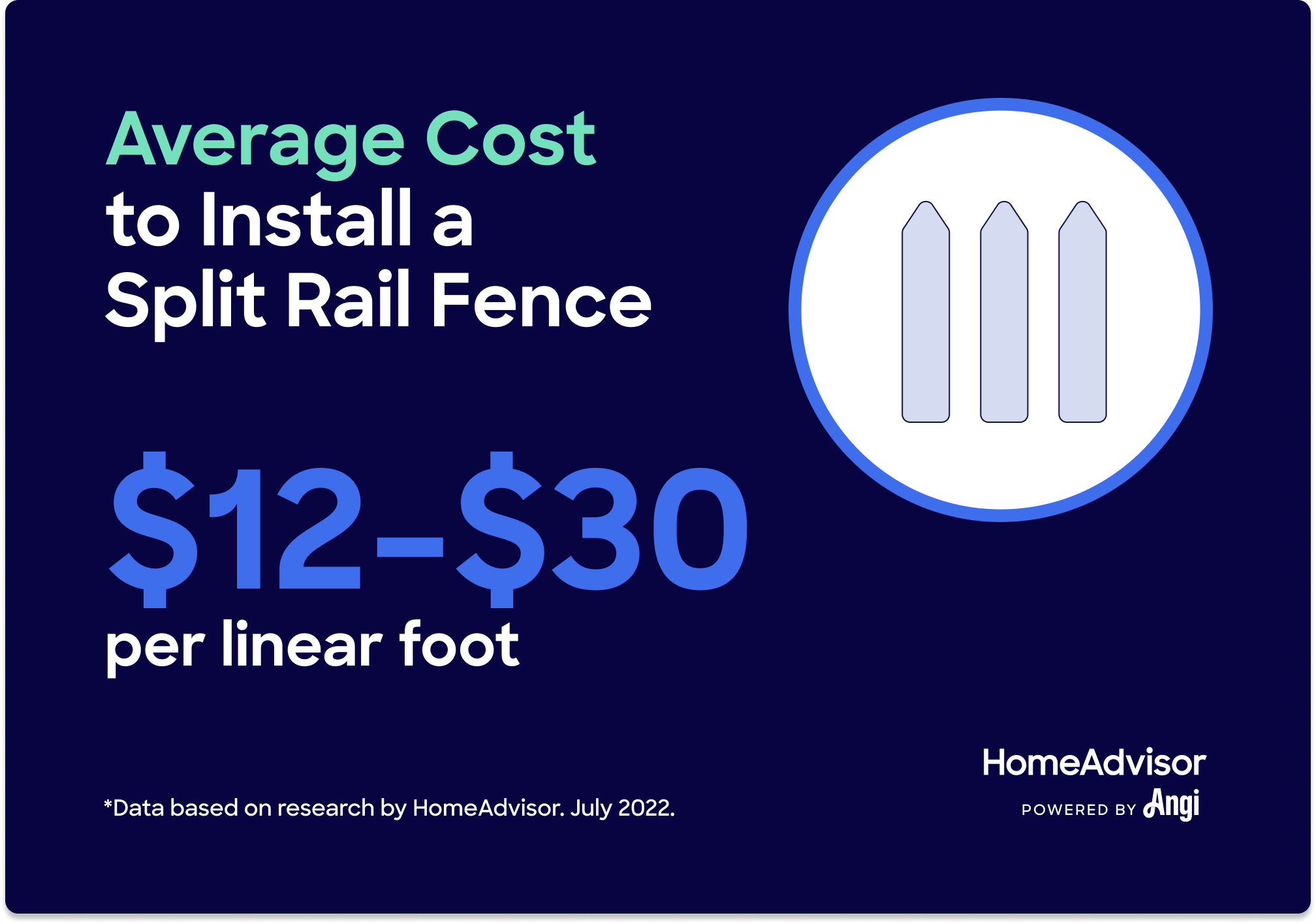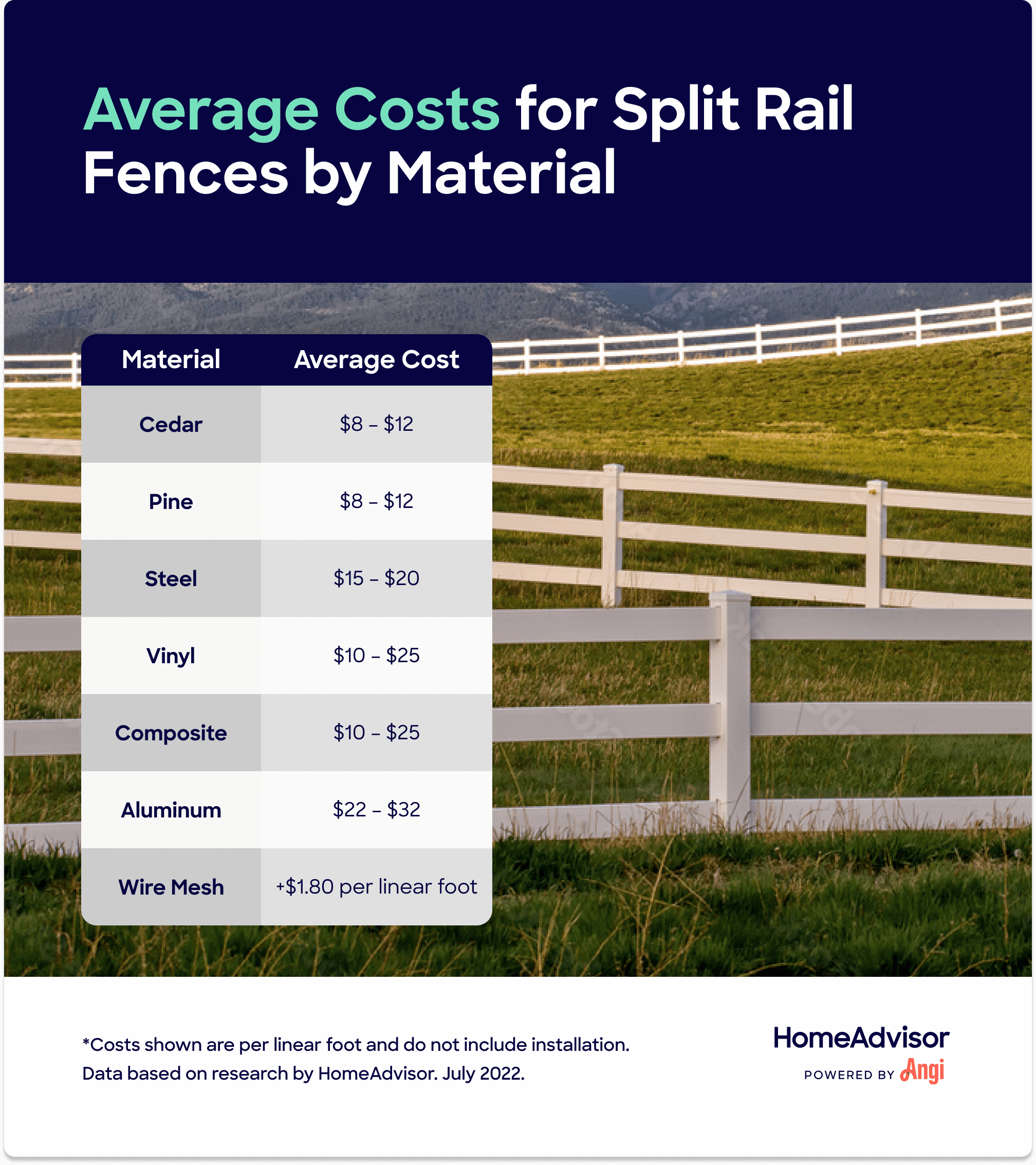How Much Does a Split Rail Fence Cost?
Typical Range:
$1,200 - $3,000
Typical Range:
$1,200 - $3,000
Cost data is based on research by HomeAdvisor.
Updated August 8, 2022
Written by HomeAdvisor.A split rail fence costs $4 to $12 per linear foot for materials alone on a fence with 2 to 4 rails. That’s about $400to $1,200 for a 100-foot fence. Professional contractors typically charge for their labor by linear foot, roughly 3x the cost of materials—taking the average split rail fence cost to $12 to $30 per linear foot, installed.
A typical 100-foot split rail fence, fully installed, can range from $1,200 to $3,000. Enclosing an entire acre with a split-rail fence can cost $9,960 to $24,900.
The exact cost to install a split rail fence, like all fencing costs, will vary not only by the size of the fence but also by the terrain, material, local labor rates, height, and several other cost factors.
The makeup of your property, including the slope of the land, the soil quality, and the accessibility, are all factors to consider when pricing out your split rail fence installation. If you hire a fence contractor, they might discuss the following factors when handing in their proposal.
Easy-to-work-with soil will yield the lowest installation price, but moderately difficult soil can add $100 or more to your project. Exceptionally difficult soil, like rocky soil, can increase the project cost by more than $1,000 for a 100-foot fence.
Rocky soil can prove the most difficult, but the professional fence contractor may also charge more for:
Sandy soil: Easy to dig but may require extra moisture to pack. Contractors may charge more for the transportation of water to the site.
Loamy soil. Easy to work with but unstable. Contractors may charge more for larger posts or gravel to add post holes for stability.
Clay. Dense and sticky. Contractors may charge more because the installation time takes longer.
Slope can affect the overall post and rail fence installation cost in the same way that soil can, from $100 to $1,000+ for fences built on a steeper slope.
In most areas of the country, properties have at least a slight grade. Building a fence on an incline requires tools and skills most homeowners do not possess. To ensure your fence looks and functions properly, you should hire a pro to help you with both planning and building.
In general, fence contractors charge $30 to $80 an hour. Hard-to-reach areas of your property may add several hours of project time, increasing the cost by several hundred dollars. The additional cost depends on how inaccessible the land is and how much time it adds to the project.
That means pastures and gardens in hard-to-reach areas of your property will cost more to fence because transporting equipment, materials, and laborers to the site takes more time and resources. And structures on easy-to-access property lines will be less expensive to erect.
Material costs can vary by fence height and number of rails, from $200 for a two-rail fence to $2,000 for a five-rail fence (100 feet in length). The table below breaks down split rail fence cost (materials only) by number of rails for a 100-foot fence.
| Number of Rails | Total Material Cost |
|---|---|
| 2 | $200 – $800 |
| 3 | $300 – $1,200 |
| 4 | $400 – $1,600 |
| 5 | $500 – $2,000 |
A typical post and rail fence is 48 inches tall, but they might reach 60 inches when protecting horses or other livestock. In general, the higher the fence, the costlier the installation.
During the installation of your split rail fence, you may encounter other fees that increase the overall cost:
Tree or debris removal: $200–$2,000 per tree. If your contractor needs to remove any trees or debris during the installation, you may have to contract out another professional, like a local tree removal company.
Surveying: $350–$675. You may need a land survey to accurately plot out your property line. The larger your property (and the more inaccessible it is), the more you will pay in land survey costs.
Painting or staining: $750–$4,250. Only factor in the cost to paint or stain a fence if the aesthetic is important. Landowners using the split rail fence to contain cattle may not paint or stain the fence, while homeowners integrating the fence into their yard’s landscaping may opt for this extra cost.
Permits: $20–$60. If the job requires a permit, the cost is typically negligible compared to larger building permit costs.
Gates: $240–$280 per gate. Gates are more expensive than a typical section of a post and beam fence.
Materials for a split rail fence can cost from $4 to $12 per linear foot; the more rails on the fence, the higher the cost. Contractors typically charge for labor by the linear foot; a single linear foot of split rail fence costs $12 to $30 fully installed.
On average, an acre of land will require 830 linear feet of fencing material, or $9,960 to $24,900 per acre, installed.
Larger jobs may sit at the lower end of the range per acre due to reduced overhead. Your professional should be able to provide a discounted quote for materials and labor prior to the start of the project.
The fence material you choose can impact the overall split rail fence cost, from $8 per linear foot for cedar or pine up to $32 per linear foot for aluminum.
Vinyl or PVC fencing is a moderately priced option for post and rail. Vinyl fences cost $10 to $25 per linear foot for materials alone. With labor costs included, the price increases to $15 to $33 per foot.
In addition to the high price tag, vinyl can become brittle in cooler temperatures. In cold climates, when it comes to wood versus vinyl fencing, wood is the better choice. Vinyl can look like real wood but is smooth to the touch. The cost to repair a vinyl or PVC fence varies based on which part needs attention.
Composite fences, like PVC fences, cost roughly $10 to $25 per linear foot for materials and an additional $5 to $8 per foot for labor. Like vinyl, composite can become brittle in cooler temperatures. Unlike vinyl, composite does have the texture of wood grain.
The cost of wood fencing ranges from $8 to $12 per linear foot for materials—much cheaper than vinyl and composite. But installing a cedar fence is more expensive on the labor side because of the additional assembly required. Installation for a cedar fence can range from $12 to $30 per foot.
Pine is the other low-cost wood option. Like cedar, installing a pine fence costs $8 to $12 per linear foot for the materials or $12 to $30 per linear foot.
These prices include any necessary weatherproofing but do not include the cost to paint or stain.
When you hire a local fence contractor, you can also ask about black locust wood. This is a long-lasting wood with a higher price tag but may be worth the investment over time.
The cost of installing an aluminum fence is much higher, from $22 to $32 per linear foot for materials alone. The high cost of aluminum makes this material an uncommon choice, especially for larger projects meant to contain cattle.
While not as expensive as aluminum, steel is still a costly option for a split rail fence, ranging from $15 to $20 for materials alone.
You can purchase a 100-yard roll of 4-foot-tall wire mesh for $180. (That’s about $0.60 per linear foot.) Some people add wire mesh to keep small pets, like dogs, inside the fence. Wire mesh can also keep unwanted animals, like raccoons and coyotes, away from your garden or livestock.
Installing wire mesh is an easy DIY project to tackle after the contractor has finished the fence installation. In that case, your split rail fence with wire mesh cost is simply the price of the materials.
The bulk of a new split rail fence cost is in the materials alone, so tacking on labor costs won’t affect the overall price by much. While more experienced handypeople might feel comfortable going the DIY route, installing a fence, especially a large one encompassing a lot of land, is an arduous, time-consuming task better left to professionals.
Plus, when you hire a fence contractor, you can ensure the work will get done correctly, and they can help you coordinate any additional work needed, like tree removal or land surveying. Even if you plan to install the fence yourself, consider hiring a pro to assess your property, plan the build, and calculate your materials.
The cost to hire a fencing professional is worth the time, money, and long-term savings of avoiding even one costly mistake throughout the process.
Like firewood, fence wood should be a rot-resistant species like oak, cedar, walnut, or black locust. Pine is a relatively inexpensive option, but you must weatherproof it.
When making your selection, you may also want to consider that the cost to repair a fence usually depends on the type of wood you choose.
To calculate how much material you need, you must first measure the outer boundaries of the property. Since rails come pre-cut in 8- to 11-foot sections, you may need to adjust your layout or shorten the fence rails. You should also account for any sloped land and/or gates.
Consider hiring an experienced professional with the necessary surveying tools and carpentry skills needed for planning. Otherwise, you may end up with the wrong amount of materials.
| Line Item | Cost | Description |
|---|---|---|
| Materials | $260 – $370 | Split cedar rails, Posts with rail holes, 10-foot spacing, Includes necessary overage and local delivery |
| Labor | $105 – $255 | Lay out post locations, Dig post holes up to 3 feet deep, Set wood posts in concrete, Install and secure rails, Includes planning, material acquisition, site prep/cleanup |
| Supplies | $35 – $45 | Fasteners, Post concrete, Connectors |
| Equipment | $70 – $100 | Daily rental allowance, for post hole auger, miter saw, pneumatic nailer, and portable concrete mixer |
| Total | $470 – $765 |
Normally, the finished height of a post and rail fence is 48 inches, or four feet. With horses or other livestock, the height should be 60 inches, or five feet.
Expect to pay between $240 and $280 for a driveway gate made of two 4-feet-wide by 4-feet-tall sections with closing latches.
Split rail fences work for horses and livestock because a horse is less likely to get hurt or get a hoof hung on this type of barrier. You must build them a minimum of five feet tall to deter horses from jumping and people from reaching over the structure.
Split rail fences can last 15 to 30 years or longer, depending on the material. Staining wood ensures it will last longer; some composite fences will last longer than wood fences, especially pine and cedar. Aluminum and steel fences can last even longer than wood and composite fences but are more expensive to install.


